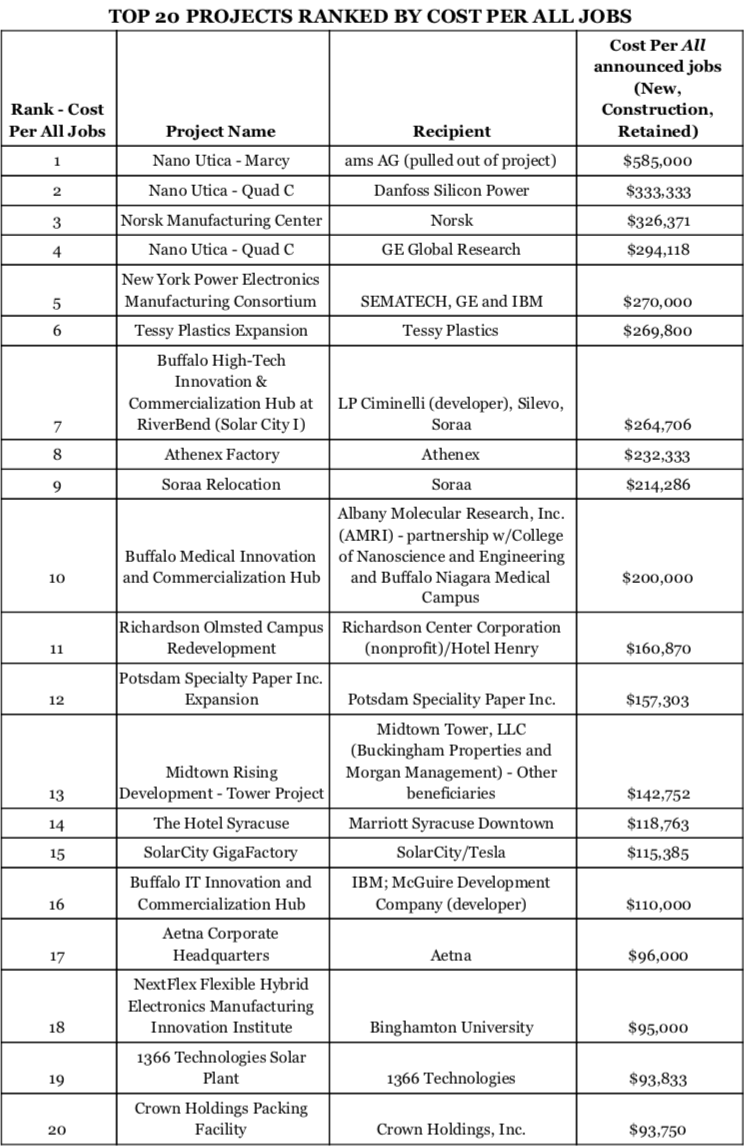Analysis of Governor’s Press Releases Shows Costs to Public for Business Subsidy Deals Varies Wildly
Analysis of Governor’s Press Releases Shows Costs to Public for Business Subsidy Deals Varies Wildly
Most Costly Jobs Slated to Cost NYS Taxpayers $585K
Assembly Must Join Senate, Pass Database of Deals So Public Can See True Costs of Subsidies To Businesses
According to an analysis by Reinvent Albany, since 2014 Governor Cuomo has announced 249 deals in which New York State taxpayers would provide subsidies to businesses totaling $4 billion.
While the governor’s press releases are only estimates, they show that the cost per job varies enormously depending on the type of deal. Reinvent Albany’s analysis underscores the need for the Assembly to join the Senate and pass a Database of Deals that clearly shows the real cost per job of state subsidies to businesses.
According to the Governor’s Press Releases Issued Since 2014:
- The most expensive publicly funded new jobs were planned for Marcy Nano-Center and cost taxpayers $585,000 each. ($585m state funds/1,000 jobs. This deal fell through, but a successor plan is still budgeted.)
- The Governor’s 10 most costly subsidy deals were slated to cost taxpayers more than $200,000 per job and total $1.8 billion, or 44% of all announced state subsidies, mostly for computer chip and solar panel factories while only producing 5,503 jobs.
- 178 of the 249 announced projects were planned to cost taxpayers under $20,000 per job. 16 cost more than $100,000 per job and of those 16, 10 cost $200,000 or more per job and 3 cost $300,000 or more per job.
- Overall, the governor announced $4 billion in planned taxpayer spending intended to create or retain 109,574 jobs.
- The average estimated cost per job to taxpayers was $31,866.
- The median taxpayer subsidy was $11,000 per job.
What’s a “Job?”
Neither the governor’s office nor NYS government has a standard definition of a “job” that allows for apples to apples comparisons of subsidy projects. Jobs can include jobs created or retained, and include temporary, permanent, full-time, part-time jobs. The Database of Deals bill, A8175A, does include a uniform definition of job and would greatly increase the transparency of state subsidy deals. The Database of Deals passed the senate 62-0.
What’s a Project?
Careful readers will notice that some mega-projects are listed twice under different names, with different budgets. For instance the Riverbend/Tesla solar panel factory is listed as Solar City and Buffalo High Tech Hub at Riverbend. That’s because the Governor’s office issued press releases with different names and budget numbers in June and September 2014. Our point here is to show that a Database of Deals is badly needed to keep these projects and their costs straight.
Costly Jobs
According to the governor’s own optimistic estimates, the most expensive taxpayer cost per job was a whopping $585,000 subsidy for the planned construction of a 360,000 square foot chip fab factory at Marcy Nanocenter at SUNY Polytechnic for ams AG. The deal fell apart when ams AG, the Austrian company promising 1,000 jobs to be the factory’s leasee, pulled out, over concerns the timetable for completing the chip fab would not be met as the result of the fallout from the arrest of Alain Kaloyeros for bid rigging, the former head of SUNY Polytechnic.
The Nano Utica Initiative projects, which includes the Marcy Nanocenter, is the worst bang for buck for taxpayers. The Nano Utica Computer Chip Commercialization Center (Quad C) deal with Danfoss Silicon Power will cost the public $333,333 per job. Danfoss has promised to create 300 new jobs over 15 years while leasing Quad C’s two cleanrooms, a lab and office space and the state’s tools for packaging power electronics equipment. A preceding agreement with GE Global Research would have cost $294,118 per job but GE Global Research backed out and decided to have Danfoss come in and run the facility instead. The number of jobs committed fell from 850 to 300.
The Governor’s high-profile economic development efforts in Buffalo are similarly plagued by some of the highest costs to taxpayers per job. The Tesla (previously Solar City) Gigafactory – which cost taxpayers $750 million – has an announced cost per job of $115,385. A promised Medical Innovation Hub supporting pharmaceutical research and development at the site was subsidized at $200,000 per job. The IBM Buffalo Innovation Center housed in the Buffalo Information Technologies Innovation and Commercialization Hub in downtown Buffalo received $55 million from the Buffalo Billion initiative for just 500 IT jobs at a rate of $110,000 per job for the first phase of its operation.
Below is a listing of the top 20 projects announced by the Governor with the highest taxpayer cost per job:
The full list of 249 projects is downloadable here.
The Solution: A Database of Deals
The groups have proposed a “Database of Deals” to reveal exactly this type of information about economic development projects, amongst other important data. A Database of Deals would list all the taxpayer subsidies received by a corporation including the type of subsidy, the number and type of jobs created or retained, and the cost per job to taxpayers. It would also define what a job is and track the different types of jobs created or retained. The state spends $4 billion in economic development annually yet the public has no way of accounting for which programs work best, and whether the state is getting a sufficient return on its investment in jobs produced or retained, or capital investments. Florida, Maryland, Indiana and New York City, among others, have a Database of Deals.
Reinvent Albany and fiscal and good government watchdog groups have called on the Assembly to join the Senate, which has already passed a Database of Deals (A.8175-A(Schimminger) & S.6613-B(Croci)). The Database of Deals was in the one house budget bills of both houses, and has 34 co-sponsors in the Assembly.

